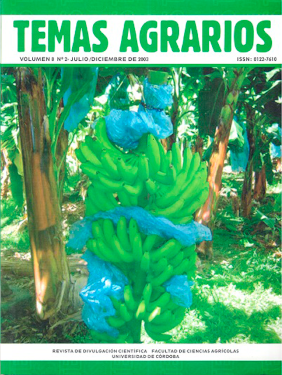Meloidogyne incognita (Kofoid and White, 1919) Chitwood 1949 y Meloidogyne arenaria (Neal 1889) Chitwood 1949: root- knot nematodes in guava (Psidium guajava L.) C.V. apple in Monteria, Córdoba
Meloidogyne incognita (Kofoid and White, 1919) Chitwood 1949 y Meloidogyne arenaria (Neal 1889) Chitwood 1949: Nematodos de las nudosidades radiculares en Guayaba (Psidium guajava L.) c.v manzana en Montería, Córdoba

This work is licensed under a Creative Commons Attribution-NonCommercial 4.0 International License.
Show authors biography
The objective of the present research was to identify at the species level and using morphological and morphometric parameters the root-knot nematode present in guava’s crop in Monteria. Samples from roots and ryzospheric soil were taken and the female, male and second stage juvenile larvae (J2) were obtained using the acid sodium hypochlorite-fuscine, mesh centrifuge and egg mass eclossion, respectively. Two types of perineal patterns were observed: the first one with high square dorsal arch, stilettos with 14 to 16 µm, flat and wide nodules and DGO distance of 2 to 4 µm. The males showed a rounded lip disc and centrally concave stilettos with 22 to 25 µm, flat and rounded nodules and a DGO distance of 2 to 4.5 µm, a typical fact of the M. incognita species. The second patterns has low and rounded dorsal arch. The strives form a shoulder, stilettos with 13 to 17 µm, wide and rounded nodules in the posterior zone, the DGO distance was 3 to 6 µm. All this characteristics are typical of the M. arenaria species. The results showed for first time the simultaneous presence of M. incognita and M. arenaria attacking guava’s crop in the Colombian Caribbean Coast.
Article visits 1209 | PDF visits
Downloads
- Cuadra, R. y Quincosa, A. 1982. Comportamiento de diferentes especies de Psidium como patrones para guayabo resistentes a Meloidogyne. Revista Ciencias de la Agricultura 13:19–26
- Daykin, M. y Hussey, R. 1985. Staining and histopathological techniques in Nematology. En: Bartker, K.; Carter, C. y Sasser, J. (Ed). An advanced treatise on Meloidogyne . Vol. II, Methodology. North Carolina State University Graphics, p.39-48
- Eisenback, J. 1985. Diagnostic characters useful in the identification of the four most common species of rooot-knot nematodes (Meloidogyne spp). En: Bartker, K.; Carter, C. y Sasser, J. (Ed). An advanced treatise on Meloidogyne . Vol. II, Methodology. North Carolina State University Graphics, p.95-112
- Eisenback, J.; Hirschmann, H.; Sasser, J. y Triantaphyllou, A. 1981. A guide to the four most common species of root-knot nematodes (Meloidogyne species) . Plant Pathology and Genetics. North Carolina State University and the United States Agency for International Development, Raleigh, p.45-60 21
- Hooper, D. 1986. Extractión of free-living stages of soil. In: Southey, J. (Ed). Laboratory methods for work with plant and soil nematodes. Ministry of Agriculture Fisheries and Food, Reference Book 402. Her Majesty´s Stationery Office. p. 5-30
- Jaraba-Navas, J.; Guzmán-Plazola, R.; Caswell-Chen, E.; Zavaleta-Mejía, E. y Del Prado, I. 2001. Especies y razas de Meloidogyne asociadas al cultivo del Tomate (Lycopersicon esculentum Mill.). Tesis M.Sc., Especialista en Fitopatología. Colegio de Postgraduados, Montecillos, p.98
- Jepson, S. 1987. Identification of root-knot nematodes (Meloidogyne species). C.A.B. International United Kingdom. Londres, p.265
- Karssen, G. y Van Hoerselaar, T. 1998. Revision of the genus Meloidogyne Göldi, 1892 (Nematoda: Heteroderidae) in Europe. Nematologica 44:713-788
- Mosquera, A.; Murcia, N. y Varón de Agudelo, F. 1995. Susceptibilidad del guayabo a nematodos fitoparasitos. ASCOLFI INFORMA 20:71-75
- Orton, W. 1972. Meloidogyne javanica. C.I.H. Descriptions of Plant-parasitic Nematodes Set 1, No. 3. Commonwealth Institute of Helminthology, St. Albins, p.8
- Paéz, A. y Roa, N. 2003. Identificación de la nematofauna asociada a cultivares de guayaba (Psidium guajaba L.) en el municipio zona bananera, departamento del Magdalena. ASCOLFI INFORMA. 29:27-28.
- SADECOR (Secretaría de Agricultura de Córdoba). 2001. Anuario estadístico, p.366-368
- Sosa-Moss, C. 1985. Report on the status of Meloidogyne research in México, Central América and the Caribbean countries. En: Bartker, K.; Carter, C. y Sasser, J. (Ed). An advanced treatise on Meloidogyne . Vol. I, Methodology. North Carolina State University Graphics, p.327-346
- Villota, F, y Barón, F. 1997. Evaluación de materiales de guayaba (Psidium guajava) por su comportamiento al ataque de Meloidogyne incognita Raza Z. Fitopatología Colombiana 21:31-37




















